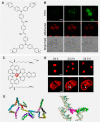Aggregation-Induced Emission (AIE), Life and Health
- PMID: 37486125
- PMCID: PMC10416578
- DOI: 10.1021/acsnano.3c03925
Aggregation-Induced Emission (AIE), Life and Health
Abstract
Light has profoundly impacted modern medicine and healthcare, with numerous luminescent agents and imaging techniques currently being used to assess health and treat diseases. As an emerging concept in luminescence, aggregation-induced emission (AIE) has shown great potential in biological applications due to its advantages in terms of brightness, biocompatibility, photostability, and positive correlation with concentration. This review provides a comprehensive summary of AIE luminogens applied in imaging of biological structure and dynamic physiological processes, disease diagnosis and treatment, and detection and monitoring of specific analytes, followed by representative works. Discussions on critical issues and perspectives on future directions are also included. This review aims to stimulate the interest of researchers from different fields, including chemistry, biology, materials science, medicine, etc., thus promoting the development of AIE in the fields of life and health.
Keywords: aggregation-induced emission; bioimaging; biomedical application; combined therapy; detection; luminescent material; monitoring; phototheranostics; precision medicine.
Conflict of interest statement
The authors declare no competing financial interest.
Figures





























Similar articles
-
Recent Advances in Aggregation-Induced Emission Materials and Their Biomedical and Healthcare Applications.Adv Healthc Mater. 2021 Dec;10(24):e2101055. doi: 10.1002/adhm.202101055. Epub 2021 Aug 21. Adv Healthc Mater. 2021. PMID: 34418306 Review.
-
The Biological Applications of Two Aggregation-Induced Emission Luminogens.Biotechnol J. 2019 Dec;14(12):e1900212. doi: 10.1002/biot.201900212. Epub 2019 Sep 17. Biotechnol J. 2019. PMID: 31469239 Review.
-
Bringing Inherent Charges into Aggregation-Induced Emission Research.Acc Chem Res. 2022 Jan 18;55(2):197-208. doi: 10.1021/acs.accounts.1c00630. Epub 2022 Jan 5. Acc Chem Res. 2022. PMID: 34985255 Review.
-
Aggregation-Induced Emission (AIE) Dots: Emerging Theranostic Nanolights.Acc Chem Res. 2018 Jun 19;51(6):1404-1414. doi: 10.1021/acs.accounts.8b00060. Epub 2018 May 7. Acc Chem Res. 2018. PMID: 29733571
-
Polymeric AIE-based nanoprobes for biomedical applications: recent advances and perspectives.Nanoscale. 2015 Jul 21;7(27):11486-508. doi: 10.1039/c5nr01444a. Epub 2015 May 26. Nanoscale. 2015. PMID: 26010238 Review.
Cited by
-
Amphiphilic Polyurethane with Cluster-Induced Emission for Multichannel Bioimaging in Living Cell Systems.ACS Macro Lett. 2024 Jan 16;13(1):52-57. doi: 10.1021/acsmacrolett.3c00657. Epub 2023 Dec 26. ACS Macro Lett. 2024. PMID: 38147539 Free PMC article.
-
Co-Assembled Nanosystems Exhibiting Intrinsic Fluorescence by Complexation of Amino Terpolymer and Its Quaternized Analog with Aggregation-Induced Emission (AIE) Dye.Nanomaterials (Basel). 2024 Oct 11;14(20):1631. doi: 10.3390/nano14201631. Nanomaterials (Basel). 2024. PMID: 39452967 Free PMC article.
-
Understanding the AIE phenomenon of nonconjugated rhodamine derivatives via aggregation-induced molecular conformation change.Nat Commun. 2024 Feb 2;15(1):999. doi: 10.1038/s41467-024-45271-6. Nat Commun. 2024. PMID: 38307892 Free PMC article.
-
Examining Sound, Light, and Vibrations as Tools to Manage Microbes and Support Holobionts, Ecosystems, and Technologies.Microorganisms. 2024 Apr 30;12(5):905. doi: 10.3390/microorganisms12050905. Microorganisms. 2024. PMID: 38792734 Free PMC article. Review.
-
Emission in the Biological Window from AIE-Based Carbazole-Substituted Furan-Based Compounds for Organic Light-Emitting Diodes and Random Lasers.ACS Omega. 2024 Sep 18;9(39):40769-40782. doi: 10.1021/acsomega.4c05484. eCollection 2024 Oct 1. ACS Omega. 2024. PMID: 39371987 Free PMC article.
References
-
- Bujalkova M.; Straka S.; Jureckova A. Hippocrates’ humoral pathology in nowaday’s reflections. Bratislavske lekarske listy 2001, 102 (10), 489–492. - PubMed
-
- World Health Organization . WHO international standard terminologies on traditional medicine in the Western Pacific Region; WHO Regional Office for the Western Pacific: Manila, 2007.
Publication types
MeSH terms
Substances
LinkOut - more resources
Full Text Sources
Other Literature Sources
Research Materials

